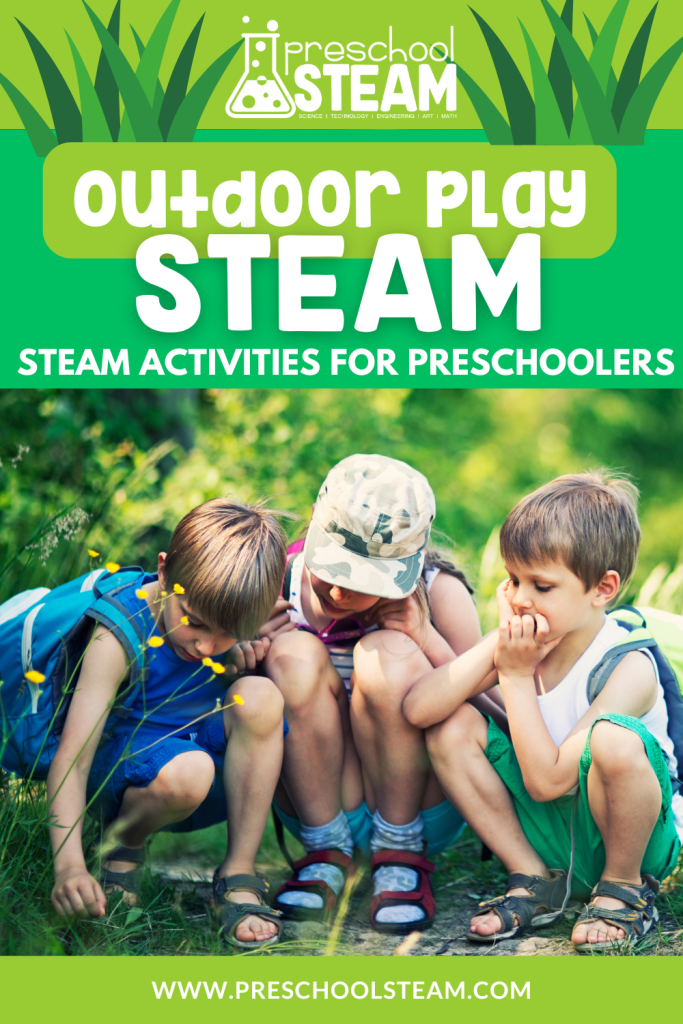Do You Want to Make STEAM Learning Easier? Take It Outside. Are you looking for a simple way to integrate STEAM into your preschool classroom? The answer might be as easy as stepping outdoors! Nature is a built-in STEAM playground where children can explore, create, and problem-solve in a hands-on way. Outdoor learning supports curiosity, creativity, and critical thinking, making it the perfect fit for a play-based STEAM approach.

Why Outdoor Play Supports STEAM Learning
Outdoor environments provide endless opportunities for meaningful STEAM experiences. Whether children are collecting leaves, stacking rocks, or digging in the soil, they are naturally engaging in problem-solving, experimentation, and scientific inquiry. Plus, outdoor learning fosters communication and collaboration as children work together to explore their surroundings.
3 Ways Outdoor Play Supports STEAM Learning
1. Outdoor Play Encourages Natural Curiosity
Young children are natural scientists. When they dig in the dirt, watch a bug crawl, or feel the wind on their face, they are engaging in scientific observation and discovery. Outdoor environments encourage children to ask questions, make predictions, and explore through hands-on experiences.
➡ Try this: Set up a nature scavenger hunt where children find and sort objects by size, color, or texture. This integrates math, classification, and observation skills while allowing children to explore freely.
2. The Outdoors is a Perfect Space for Engineering Exploration
Loose parts in nature inspire creative building and problem-solving. Whether stacking rocks, arranging sticks, or designing forts, children experiment with balance, stability, and structure. Outdoor play allows children to use real-world materials, which strengthens their spatial reasoning and problem-solving skills.
➡ Try this: Challenge children to build a bridge using only sticks and leaves. Can they make it strong enough to hold a small toy? Encourage them to test and modify their designs!
3. Play-Based Outdoor STEAM Reduces Teacher Stress
Instead of prepping complex activities, let the outdoor environment guide the play. When children explore freely, they ask their own questions, test their own ideas, and make their own discoveries. This allows educators to take on the role of facilitator rather than instructor, creating a more relaxed and natural learning environment.
➡ Try this: Introduce shadow tracing. Place toys outside at different times of the day and trace their shadows. Observe how they change and discuss why!
Bring Play-Based STEAM Outside
Outdoor play is a simple yet powerful way to bring STEAM to life in your classroom. By encouraging children to explore and experiment in nature, educators can create engaging, hands-on learning experiences with minimal preparation.
📢 Looking for more play-based STEAM activities that make learning hands-on and engaging?
🎨 Join our Preschool STEAM Pathways membership for exclusive lesson plans, activity guides, and hands-on ideas designed to bring STEAM learning to life in your classroom!💡 What outdoor STEAM activities have been a hit in your classroom? Share your favorite ideas in the comments! Outdoor play is a simple yet powerful way to bring STEAM to life in your classroom. By encouraging children to explore and experiment in nature, educators can create engaging, hands-on learning experiences with minimal preparation. Which outdoor STEAM activity will you try first? Let us know in the comments!
Leave a Reply